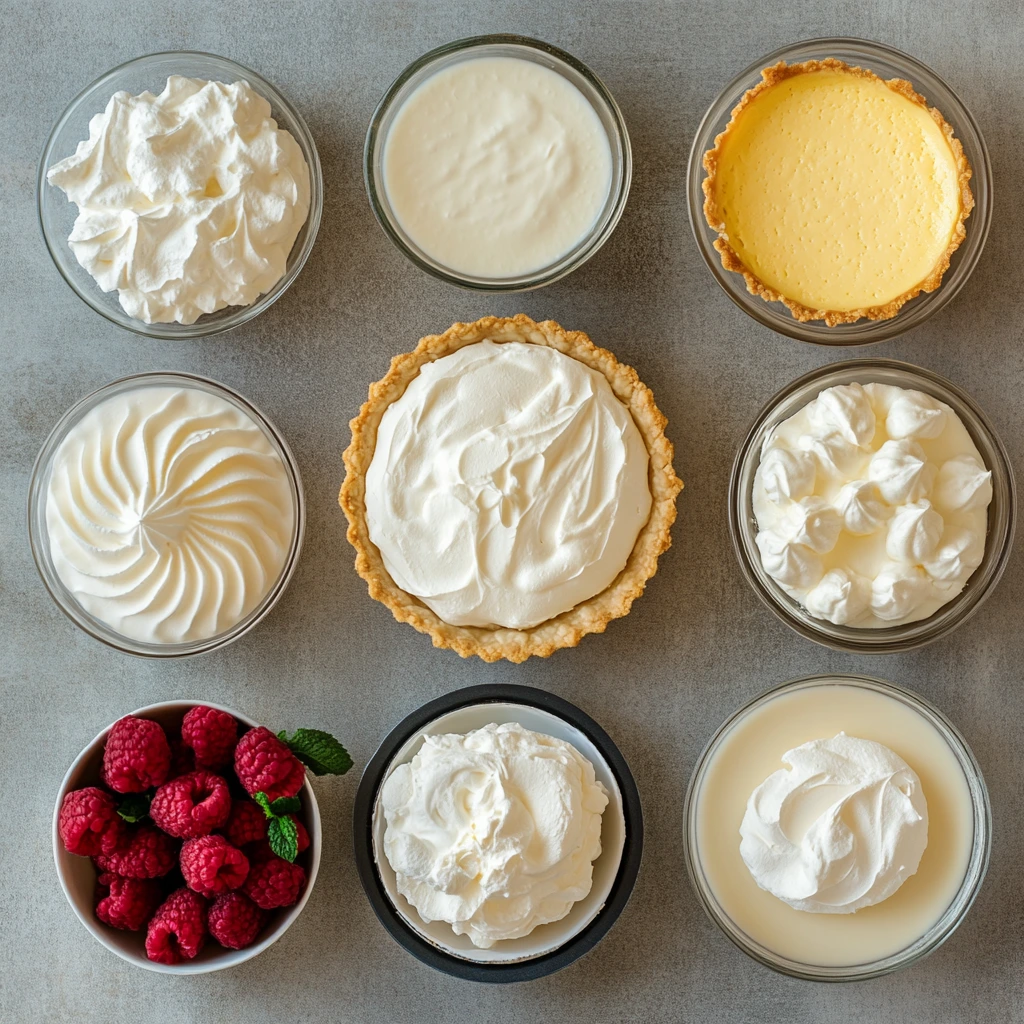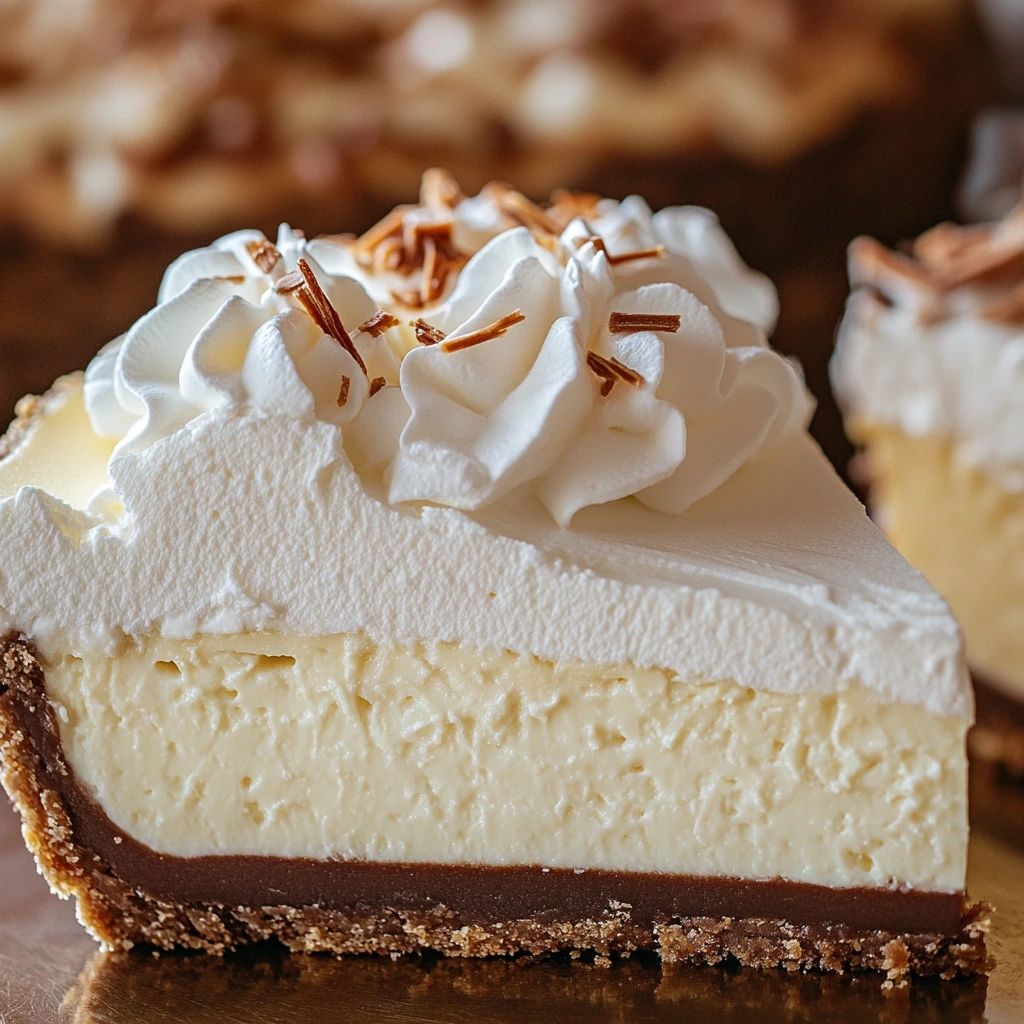What is the difference between cream pie and cheesecake? A cream pie typically includes a flaky or crumbly crust filled with creamy custard or pudding, and chefs often top it with whipped cream or meringue. In contrast, cheesecake delivers a rich and dense texture, combining cream cheese or ricotta with eggs and sugar, baked on a graham cracker or pastry crust.
When asking what is the difference between cream pie and cheesecake, the core contrasts lie in their textures, preparation methods, and key ingredients. Cream pies feature a light, velvety filling and require chilling to set, while cheesecakes provide a denser, more substantial bite through baking.
What is the difference between cream pie and cheesecake when it comes to serving styles? Cream pies are usually served chilled, enhancing their creamy texture, whereas cheesecakes, especially baked versions, are often served at room temperature to maximize their rich flavors. Despite these differences, both desserts delight with indulgent flavors that cater to varied palates, securing their spots as staples on dessert menus worldwide.
Table of Contents
1.Historical Origins: What is the Difference Between Cream Pie and Cheesecake?
The origins of cream pie and cheesecake trace back to different periods and regions, showcasing their unique cultural roots and evolution over time. Cream pie, often associated with American cuisine, emerged as a dessert popularized in the 19th century. Its roots lie in the development of custard-based recipes, which became accessible with the widespread availability of dairy and sugar. Variations like banana cream pie and coconut cream pie gained prominence in the early 20th century, symbolizing comfort and indulgence in American households.
Cheesecake, on the other hand, boasts a much older history, with origins dating back to ancient Greece. The earliest known cheesecake recipes were served to athletes during the first Olympic Games in 776 BCE. Romans later adopted and modified the dish, spreading it across Europe. During the Middle Ages, regional variations emerged, using local ingredients such as ricotta in Italy or quark in Germany. Cheesecake gained global fame with the invention of cream cheese in the United States in the late 19th century, leading to the creation of the New York-style cheesecake.
Cream pie’s evolution showcases American innovation and comfort-focused cuisine, while cheesecake’s journey highlights its adaptability and enduring appeal across centuries.
2.The Key Ingredients: What is the Difference Between Cream Pie and Cheesecake?
Cream pie and cheesecake differ significantly in their ingredient profiles, contributing to their unique textures, flavors, and appearances. Each dessert employs specific components that define its character, from the crust to the filling and toppings.
2.1 Crust Types
The crust serves as the foundation for both desserts but varies in texture and composition. Cream pie typically uses a flaky pie crust made from butter or shortening, creating a delicate and crisp base. Some variations, like chocolate or graham cracker crusts, are also common. Cheesecake, on the other hand, predominantly features a dense and crumbly crust made from crushed graham crackers, digestive biscuits, or cookies mixed with butter. This base is pressed firmly to support the weight of the rich filling.
2.3 Filling Bases
The defining difference lies in the filling. Cream pie fillings are custard-like and rely on milk or cream, eggs, sugar, and cornstarch or flour as a thickening agent. These fillings are cooked on the stovetop, then cooled to set. Popular flavors include vanilla, chocolate, banana, or coconut.
In contrast, cheesecake’s filling is much denser and relies on cream cheese, ricotta, or quark, blended with sugar, eggs, and often sour cream or heavy cream. Cheesecake fillings are typically baked, though no-bake versions use gelatin or whipped cream for setting.
2.4 Toppings
Toppings add the finishing touch to both desserts. Cream pies are crowned with whipped cream or meringue, sometimes garnished with shaved chocolate, fruit, or toasted coconut. Cheesecakes often feature a layer of sour cream, fruit compote, chocolate ganache, or fresh berries, accentuating their richness.
In summary, cream pies emphasize lightness and creamy textures, while cheesecakes focus on density and richness, with their contrasting ingredient choices shaping their iconic profiles.

3.Cream Pie Ingredients
Cream pies are known for their light, velvety textures and sweet, creamy flavors. A typical cream pie consists of three main components: the crust, the custard or cream filling, and optional toppings.
1. Crust
The base of a cream pie is often a traditional pie crust made from flour, butter, and a touch of sugar. Alternatively, crumb-based crusts using graham crackers or cookies are sometimes employed for specific flavor profiles.
2. Custard or Cream Filling
The filling is the heart of a cream pie. It is usually a custard made from milk or heavy cream, egg yolks, sugar, and a thickening agent like cornstarch or flour. Vanilla, chocolate, or fruit puree is often added for flavor. The mixture is cooked on the stovetop until thickened, then poured into the crust to set.
3. Fruits and Toppings
Many cream pies feature fruits like bananas, coconut flakes, or berries mixed into or layered on the filling. The final touch is often whipped cream or meringue, providing a light, airy topping that balances the richness of the filling. Additional garnishes may include chocolate shavings, caramel drizzle, or toasted nuts, enhancing both flavor and presentation.
4.Cheesecake Ingredients
Cheesecake’s luxurious texture and rich flavor come from a carefully balanced combination of ingredients, each playing a crucial role in its iconic profile.
4.1 Base Ingredients
The core of any cheesecake is the filling, primarily made from cream cheese, which provides its creamy and tangy signature taste. Variations may use ricotta, mascarpone, or quark for a lighter or more nuanced texture. Sugar adds sweetness, while eggs act as a binding agent, giving the cheesecake its dense, custard-like consistency.
4.2 Enhancers
To deepen the flavor, many recipes include heavy cream or sour cream, which add richness and smoothness. Vanilla extract is a common flavoring, though other ingredients like lemon zest, chocolate, or pumpkin puree can be added for unique twists.
4.3 Crust
The crust, typically made from crushed graham crackers or digestive biscuits mixed with melted butter, serves as a sturdy and flavorful foundation. Some recipes use alternative crusts, like Oreo cookies or nuts, for added variety.
Cheesecake’s ingredients come together to create a dessert that is both indulgent and versatile, with countless variations suited to different tastes and occasions.
5.How Cream Pies Are Made
Making a cream pie involves a few key steps to create its signature creamy filling and flaky crust. Here’s a step-by-step guide:
1. Prepare the Crust
Begin by making a pie crust using flour, butter (or shortening), and a pinch of sugar. Roll it out and press it into a pie dish, then bake it blind (without filling) until golden and crisp. Alternatively, use a graham cracker or cookie crust by mixing crumbs with melted butter and pressing it into the dish, then chilling it to set.
2. Make the Filling
The filling is typically a custard. Combine milk or cream, sugar, egg yolks, and cornstarch (or flour) in a saucepan. Cook over medium heat, whisking constantly, until the mixture thickens. Add flavorings like vanilla or chocolate and allow the custard to cool slightly.
3. Assemble the Pie
Pour the cooled custard into the prepared crust and spread evenly. If using fruits like bananas or coconut, layer them in the filling.
4. Add Toppings
Top the pie with whipped cream or meringue. Garnish with fruit slices, chocolate shavings, or toasted coconut, if desired.
5. Chill and Serve
Refrigerate the pie until fully set, typically 2–4 hours, before slicing and serving. This chilling process ensures the pie holds its shape and enhances its creamy texture.
6.How to make Cheesecakes
Cheesecakes can be prepared using baked or no-bake methods, each resulting in a rich and creamy dessert. Here’s a step-by-step overview:
1. Prepare the Crust
Create the crust by mixing crushed graham crackers, digestive biscuits, or cookies with melted butter. Press the mixture into a springform pan and chill it to set for a no-bake version, or bake it briefly for extra firmness in a baked cheesecake.
2. Make the Filling
For the filling, blend cream cheese (or ricotta/mascarpone), sugar, and eggs until smooth. Add flavorings like vanilla, lemon zest, or chocolate, and incorporate sour cream or heavy cream for extra richness. No-bake versions replace eggs with whipped cream or gelatin for setting.
3. Assemble the Cheesecake
Pour the filling over the prepared crust. Smooth the surface with a spatula.
4. Bake or Chill
Bake cheesecakes in a water bath at a low temperature to prevent cracking, and let them cool gradually. Refrigerate no-bake cheesecakes for several hours to allow the filling to firm up.
5. Add Toppings and Serve
Top the cheesecake with fruit compotes, chocolate ganache, or whipped cream before serving. For the best texture and flavor, chill the cheesecake for several hours or overnight.

7.Differences in Cooking Techniques
What is the difference between cream pie and cheesecake in terms of cooking techniques? Cream pies rely on stovetop preparation, where cooks thicken a custard filling and pour it into a pre-baked crust before chilling it to set. This method creates the light, silky texture that cream pies are known for.
Cheesecakes, in contrast, involve slow baking in the oven, often using a water bath to allow the proteins in the eggs to set and form a dense, creamy consistency. For those wondering what is the difference between cream pie and cheesecake when comparing no-bake methods, no-bake cheesecakes are refrigerated with gelatin or whipped cream to achieve a smooth, airy texture, offering a lighter alternative.
8.Variations and Regional Twists
Both cream pies and cheesecakes have inspired countless regional adaptations, each showcasing local ingredients and culinary traditions.
1. Cream Pie Variations
- Key Lime Pie: A Florida classic, made with a graham cracker crust, tangy key lime custard, and whipped cream.
- Banana Cream Pie: Popular in the United States, featuring sliced bananas layered with vanilla custard and topped with whipped cream.
- Coconut Cream Pie: A tropical favorite, combining coconut-flavored custard with toasted coconut toppings.
2. Cheesecake Variations
- New York Cheesecake: Famous for its dense, rich filling made with cream cheese, eggs, and heavy cream, baked on a graham cracker crust.
- Japanese Cheesecake: Light and airy, this variation incorporates whipped egg whites for a soufflé-like texture.
- Italian Cheesecake: Uses ricotta or mascarpone, offering a lighter, slightly grainy texture and often flavored with citrus or almonds.
- Basque Burnt Cheesecake: Originating in Spain, this crustless cheesecake is baked at high heat to develop a caramelized, burnt top and creamy center.
These variations highlight the versatility of both desserts, making them adaptable to a wide range of tastes and cultural preferences.
9.Nutritional Profiles
When comparing cream pies and cheesecakes, their nutritional profiles reveal notable differences based on ingredients and preparation methods.
1. Calories
Cheesecakes tend to be higher in calories due to their dense filling, which incorporates cream cheese, eggs, and heavy cream. A standard slice of cheesecake can range from 300 to 500 calories or more. Cream pies, depending on the filling (e.g., vanilla or chocolate), are typically lighter, with calorie counts around 250 to 400 per slice.
2. Sugar Content
Both desserts contain significant sugar, but cream pies often have a slightly higher sugar content due to the sweetened custard and whipped cream topping. Cheesecakes rely on cream cheese for richness, balancing sweetness with tanginess, though toppings like fruit compotes can add extra sugar.
10.Health Considerations
Cream pies are generally lower in fat but higher in sugar, while cheesecakes are rich in fats, especially saturated fats, from cream cheese and cream. For lighter options, cream pies with reduced-sugar fillings or no-bake cheesecakes made with yogurt can provide healthier alternatives.
In moderation, both desserts can fit into a balanced diet, but their rich ingredients make them indulgences best enjoyed occasionally.
1. Cream Pie Nutrition
Cream pies are relatively light in texture but can be calorie-dense due to their buttery crust, creamy custard, and sweet toppings. A typical slice contains around 250–400 calories, with moderate fat content primarily from cream and eggs. Sugar levels can be high, especially in flavored variations like chocolate or banana cream pies.
2. Cheesecake Nutrition
Cheesecakes are rich and indulgent, with a single slice often containing 300–500 calories or more. High in fats, especially saturated fats from cream cheese and heavy cream, they are also a source of protein due to their egg and dairy content. Cheesecakes generally have moderate sugar levels, though toppings like chocolate or caramel can increase the sugar content. Variations like no-bake or yogurt-based cheesecakes offer healthier alternatives.
11.Popularity and Cultural Influence
What is the difference between cream pie and cheesecake in terms of popularity and cultural impact? Cream pies, particularly variations like banana and coconut cream, hold iconic status in American diners and on holiday tables. Cheesecakes, on the other hand, have a more international appeal. From New York’s dense and rich style to Japan’s light and soufflé-like version, cheesecakes demonstrate global versatility and creativity.
12.FAQs: What is the Difference Between Cream Pie and Cheesecake?
Is Cheesecake Actually a Cake?
Although cheesecake carries “cake” in its name, it belongs more to the category of custard pies because of its creamy filling and crust.
What Makes a Cream Pie Different from a Custard Pie?
Cream pies stand out with their lighter, whipped fillings and creamy toppings, unlike custard pies, which use a dense, baked custard.
Cheesecake Without Cream Cheese?
Yes, you can use substitutes like ricotta, mascarpone, or silken tofu to create cheesecakes with unique textures and flavors.
Are Cream Pies Always Served Cold?
Most people chill cream pies to preserve their creamy consistency, but certain variations work well at room temperature.
H3: What Are Some Famous Cheesecake Flavors?
Cheesecake comes in many popular flavors, including chocolate, lemon, strawberry, and pumpkin, with global favorites like Japanese and Basque-style offering exciting twists.
- Fusion desserts on your mind? Learn about an innovative twist with the Philadelphia Pecan Pie Cheesecake recipe.
- Perfect pairings in dips: Discover how cheesecake and pecan pie flavors come together in a unique way with Pecan Pie Cheesecake Dip: A Sweet and Creamy Delight.
- For bar-style indulgence: Try a bite-sized take on this combination with Pecan Pie Cheesecake Bars.
- Elevate your desserts: Experience the rich blend of flavors in Caramel Pecan Cheesecake Pie.
- Debating cheesecake techniques? Explore the pros and cons of baked and no-bake styles in Is No-Bake or Baked Cheesecake Better?.

